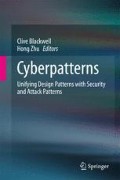Abstract
Aspect Oriented Programming is increasingly being used for the practical coding of cross-cutting concerns woven throughout an application. However, most existing AOP point-cut definition languages don’t distinguish in their application between different systems across a network. For network security there is a need to apply different aspects depending on the role a piece of code has within the larger networked system, and a new approach for this is therefore required. In this chapter we present a formalism for how this might be approached, proposing a way to capture distributed point-cuts for applying different aspects in different parts of the network. The method is based on templates that match properties within the code, and a set of flexible relationships that can be defined between them.
Access this chapter
Tax calculation will be finalised at checkout
Purchases are for personal use only
Notes
- 1.
The authors are indebted to Eduardo Pena Viña of Télécom Bretagne for identifying an error that appeared in the original version of this example.
References
Duzan G, Loyall J, Schantz R, Shapiro R, Zinky J. Building adaptive distributed applications with middleware and aspects. In: Proceedings of the 3rd international conference on aspect-oriented software development, AOSD 04. ACM Press; 2004. pp. 66–73. doi:10.1145/976270.976280.
García M, Llewellyn-Jones D, Ortín F, Merabti M. Applying dynamic separation of aspects to distributed systems security: a case study. Softw IET. 2012;6(3):231–48. doi:10.1049/iet-sen.2010.0160.
Hilsdale E, Hugunin J. Advice weaving in AspectJ. In: Proceedings of AOSD 2004: 3rd international conference on aspect-oriented software development, Lancaster, UK; 2004. pp. 26–35. doi:10.1145/976270.976276.
Horie M, Morita S, Chiba S. Distributed dynamic weaving is a crosscutting concern. In: Proceedings of the 2011 ACM symposium on applied computing—SAC 11. ACM Press; 2011. p. 1353. doi:10.1145/1982185.1982479.
Jakob H, Loriant N, Consel C. An aspect-oriented approach to securing distributed systems. In: Proceedings of the 2009 international conference on pervasive services. 2009. pp. 21–30. doi:10.1145/1568199.1568204.
Nicoara A, Alonso G, Roscoe T. Controlled, systematic, and efficient code replacement for running Java programs. SIGOPS Oper Syst Rev. 2008;42(4):233–246. doi:10.1145/1357010.1352617.
Ortín Soler F, Vinuesa Martínez LA, Félix Rodríguez JM. The DSAW aspect-oriented software development platform. Int J Softw Eng Knowl Eng. 2011;21:891–929. doi:10.1142/S0218194011005554.
Pawlak R, Duchien L, Florin G, Martelli L, Seinturier L. Distributed separation of concerns with aspect components. IEEE Comput Soc. 2000;276–287. doi:10.1109/TOOLS.2000.848768.
Rasche A, Schult W, Polze A. Self-adaptive multithreaded applications: a case for dynamic aspect weaving. In: Proceedings of the 4th workshop on reflective and adaptive middleware systems, ARM ’05. New York: ACM; 2005. doi:10.1145/1101516.1101526.
Vanderperren W, Suvée D, Verheecke B, Cibrán MA, Jonckers V. Adaptive programming in JAsCo. In: Proceedings of the 4th international conference on aspect-oriented software development, AOSD ’05. New York: ACM; 2005. pp. 75–86. doi:10.1145/1052898.1052905.
Acknowledgments
The research leading to these results has received funding from the European Union Seventh Framework Programme (FP7/2007–2013) under grant no 257930 (Aniketos). The authors are especially grateful to Francisco Ortín and Miguel García at the University of Oviedo in Spain for their contributions to this work. We would also like to thank Eduardo Pena Viña of Télécom Bretagne for interesting correspondence on the topic that led to improvements in the text.
Author information
Authors and Affiliations
Corresponding author
Editor information
Editors and Affiliations
Rights and permissions
Copyright information
© 2014 Springer International Publishing Switzerland
About this chapter
Cite this chapter
Llewellyn-Jones, D., Shi, Q., Merabti, M. (2014). Extending AOP Principles for the Description of Network Security Patterns. In: Blackwell, C., Zhu, H. (eds) Cyberpatterns. Springer, Cham. https://doi.org/10.1007/978-3-319-04447-7_6
Download citation
DOI: https://doi.org/10.1007/978-3-319-04447-7_6
Published:
Publisher Name: Springer, Cham
Print ISBN: 978-3-319-04446-0
Online ISBN: 978-3-319-04447-7
eBook Packages: Computer ScienceComputer Science (R0)

